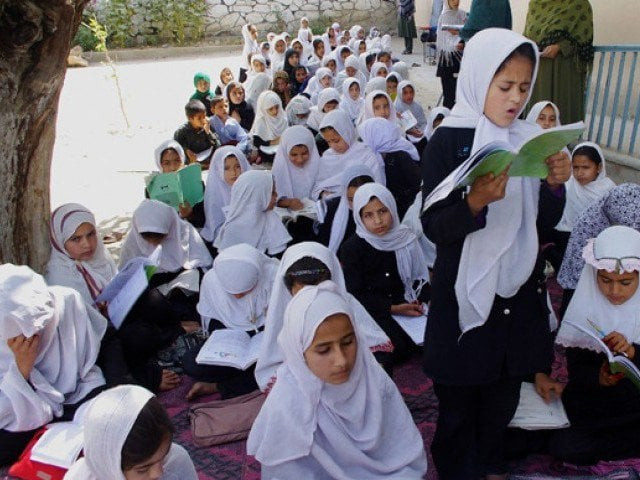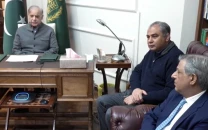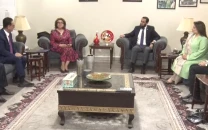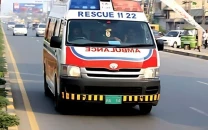Fewer Afghan girls get education in Pakistan
UNESCO report says refugee children are prepared to return across Durand Line

PHOTO: FILE
The issue is exacerbated amongst Afghan refugee girls and the disabled, with the former enjoying lower education rate than in their home country and prompting international concerns.
These concerns were expressed by the United Nations Educational, Scientific and Cultural Organisation (UNESCO) as it released its latest Global Education Monitoring (GEM) Report 2019 on migration, displacement and education: "Building bridges not walls"
The report draws attention to the plight of Afghan refugees in Pakistan, many of whom have been residents in the country for four decades.
Nearly half Afghan children out of school, rising for first time since 2002
It compares the progress for Afghan refugees in the country with their compatriots in neighbouring Iran — where one in four refugee children and undocumented Afghan children are out of school, compared to three out of four among those in Pakistan.
In Pakistan, thus, the overall primary enrollment rate of Afghan refugees was 29 per cent — a far cry from the national average of 71 per cent.
The situation for Afghan refugee girls and women is particularly stark. In Pakistan, only 18 per cent of Afghan refugee girls are enrolled in school, which is half the enrolment rate of boys (39 per cent) and less than half the rate for girls in Afghanistan.
While in Iran, 64 per cent of female Afghan refugees over the age of 15 are literate, among returnees surveyed from Nangarhar province in Pakistan, only seven per cent were literate.
K-P govt concerned over UNHCR’s ‘anti-Pakistan’ syllabus for Afghan students
Moreover, the report notes that one issue is the availability of female teachers to teach girls — seen as a requirement in light of cultural sensitivities. But with Pakistan amongst the countries where educational institutions have been targeted in violent activities, female teachers displaced by violence were hesitant to return to work, fearing for their security. This gives rise to a vicious circle where sociocultural traditions demand that adolescent girls can be taught only by women, but few female teachers are available. Hence contributing to lower enrolment rates.
Differently abled
With many Afghan refugees fleeing violence and one of the highest mined regions in the world, a number of Afghan refugee children are differently abled. However, the type of their different-ability also affected their school attendance.
Seven Indian engineers kidnapped in Afghanistan
The report noted that those with difficulty seeing were most likely to attend school (52 per cent attendance), while those with self-care difficulties were the least likely (7.5 per cent attendance).
In between were those with difficulty speaking (31 per cent) or walking (27 per cent), trauma‑originating depression or confusion (23 per cent) and cognitive difficulties (21 per cent).
Inclusion
The global report shows that eight out of the 10 top refugee-hosting countries include them in their national education systems.
While countries like Iran strived for greater inclusion of refugees — documented or not —there were some countries which practice exclusionary policies, such as Bangladesh and Thailand.
In Pakistan, refugee schools used the Afghan curriculum in preparation for their return and reintegration into the Afghan education system, despite the fact that the majority of Afghan refugees have never been to Afghanistan.
Most attend schools outside the public sector - private schools; madrassas, which are free and provide food and boarding facilities; community-based schools; and non-formal schools. The report noted that Pakistan's overall attitude towards Afghan refugees was ambivalent, Balochistan included them in its education plan at the provincial level.
"A glimmer of hope appeared in September when Prime Minister Imran Khan appeared to commit to a radical change in policy which would award citizenship to all Afghan refugees, but this disappeared, along with the policy, a few days later," noted the report's director Manos Antoninis.
"It is true that geography, history, resource availability and system capacity all affect the evolving nature of inclusion. But our report shows the benefits to refugees but also to host countries when they include refugees in national education systems."
Antoninis pointed out that given how some countries had successfully included refugees in the education systems, Pakistan could do better.
One place to start would be to sign the Convention and Protocol Relating to the Status of Refugees, like Iran.
Published in The Express Tribune, November 21st, 2018.



















COMMENTS
Comments are moderated and generally will be posted if they are on-topic and not abusive.
For more information, please see our Comments FAQ